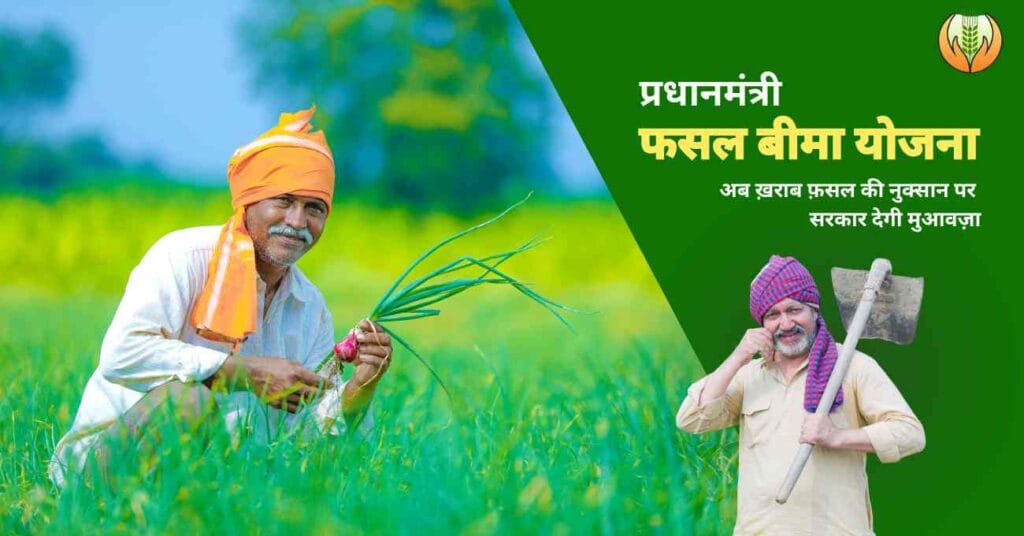Pradhan Mantri Fasal Bima Yojana | प्रधान मंत्री फसल बीमा योजना
Farming is the backbone of India’s economy. A large number of people in India depend on farming for their livelihood. But farming is not always easy. Sometimes, farmers lose their crops because of floods, droughts, or other natural disasters. This can cause big financial problems for them. To help farmers in such situations, the government started the Pradhan Mantri Fasal Bima Yojana (PMFBY), also known simply as Fasal Yojana.

What is Pradhan Mantri Fasal Bima Yojana?
Fasal Yojana, officially called Pradhan Mantri Fasal Bima Yojana (PMFBY), is a crop insurance scheme launched by the Government of India in 2016. The main aim of this scheme is to protect farmers from losses caused by crop damage due to natural disasters like:
Heavy rainfall
Drought
Floods
Hailstorms
Pests and diseases
Under this scheme, farmers pay a very low amount as insurance premium, and if their crops get damaged, they receive compensation from the insurance company. This helps them recover their losses and continue farming without falling into debt.
Why was Fasal Yojana started?
Before 2016, there were other crop insurance schemes like the National Agricultural Insurance Scheme (NAIS) and the Modified NAIS, but they had many problems. Many farmers were not joining those schemes, and even if they did, they didn’t always get compensation on time.
To solve these issues, the government launched Fasal Yojana with better rules:
Lower premium rates for farmers
Quick processing of claims
Use of modern technology like satellite images and drones to check crop damage
Direct transfer of money to farmers’ bank accounts
The idea was simple: make it easier for farmers to get insurance and help them when they need it the most.
How does Fasal Yojana work?
1. Premium Payment
Farmers who join the Fasal Yojana have to pay a small part of the insurance cost, called a premium. The rest of the amount is paid by the government.
For Kharif crops (like rice, maize): Farmers pay 2% of the total sum insured.
For Rabi crops (like wheat, barley): Farmers pay 1.5%.
For commercial or horticultural crops (like cotton, sugarcane, fruits): Farmers pay 5%.
For example, if the sum insured is ₹50,000 for a Kharif crop, the farmer only pays ₹1,000 (2%), and the government pays the remaining amount.
2. Assessment of Crop Loss
If a natural disaster or pest attack damages the crops, the loss is assessed using:
Field surveys
Satellite imagery
Mobile apps and drones
These methods ensure faster and more accurate results.
3. Compensation
Once the damage is confirmed, the insurance company transfers the compensation amount directly to the farmer’s bank account.
Who can apply for Pradhan Mantri Fasal Bima Yojana?
Any farmer in India, whether big or small, can apply for this scheme. There are two types of farmers:
Loanee farmers: Those who have taken a loan from a bank. For them, crop insurance is usually mandatory.
Non-loanee farmers: Those who haven’t taken a loan. For them, joining the scheme is optional.
Even tenant farmers and sharecroppers can apply, as long as they can prove they are farming on the land.
How to apply for Fasal Yojana?
Farmers can apply in the following ways:
Online:
Visit the official PMFBY website: https://pmfby.gov.in
Register using Aadhaar and mobile number
Fill in the application form
Upload documents (land records, sowing certificate, bank details)
Pay the premium online
Offline:
Visit the nearest Common Service Center (CSC), bank, or agriculture office
Fill in the form and submit documents
Pay the premium there
Farmers should apply within the deadline, which is usually before the sowing season begins.
Documents Required
Aadhaar card
Land documents or lease agreement (if land is rented)
Bank account details
Crop sown and area details
Passport-size photo
Benefits of Fasal Yojana
Financial Security: Farmers get money when crops are damaged, which saves them from big losses.
Low Premium: Farmers pay only a small part of the insurance amount.
Quick Claims: Use of modern technology helps in fast and fair assessment.
Direct Bank Transfer: No middlemen, so less chance of corruption.
Encourages Farming: Farmers feel safe and more confident to grow crops.
Conclusion
The Pradhan Mantri Fasal Bima Yojana is a powerful step taken by the Indian government to support the country’s farmers. With a low premium and high protection, it gives farmers the courage to face natural disasters. While there are areas that need improvement, the scheme has already made a big difference in many lives.
Every farmer should know about and use this scheme to protect their crops and future. With better implementation and awareness, Fasal Yojana can become a true game-changer for Indian agriculture.

